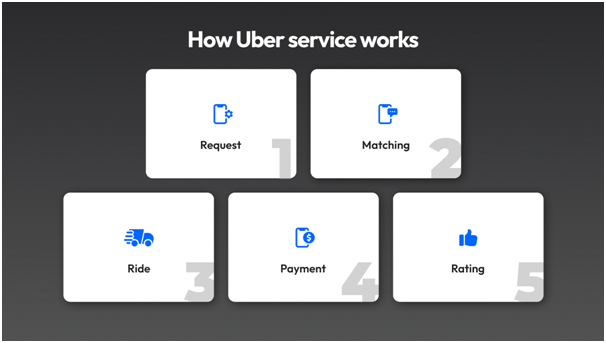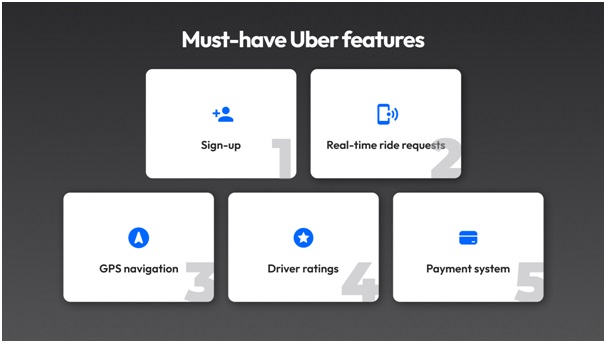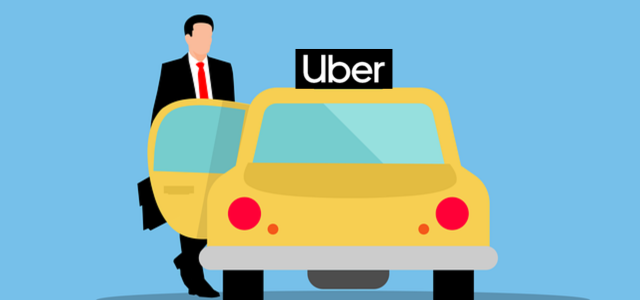Uber is a revolutionary app that has revolutionized the way people travel and get to work. It provides transportation services anywhere in the world. With Uber, passengers can get anywhere quickly and safely while avoiding the hassle of public transportation or finding parking.
Creating an app like Uber requires understanding many different technologies and concepts and a significant amount of development time. In this article, we’ll look at the features that should be included in an Uber-like app and estimate how long it would take to create each element.
Some Important Details About Uber
Uber is a top-rated ride-sharing app that covers 84 countries and more than 800 cities, providing 24/7 on-demand communication between passengers and drivers through its Android and iOS apps. The company offers users a unique ride-sharing option and has a number of other on-demand services. To date, this has been in high demand, and the Uber app is setting the trends in the industry.
Uber was created by two former Stanford students, Kalanick and Camp, in 2009 as an app intended to improve city transportation. Since then, it has grown substantially in features and scope, making it one of the most applauded apps in its category and helping propel mobile technology further into mainstream use.
Uber taxi app’s work mechanism
Apps like Uber use location-based technology to facilitate the request for a ride. After entering a destination and sending a boarding request, the app sends it to all available nearby drivers. Once one of them accepts the request, they will drive up to the boarding location to provide transportation.
Finding a driver begins when users open the mobile application and select their destination. Once they have identified their goal, technology in the app uses GPS coordinates to locate surrounding drivers who accept requests. Depending on available time or other factors, drivers can take or decline a ride request. Once both sides have agreed on terms for the ride, payment information is collected, followed by confirmation of payment status from both parties. After the trip, riders pay for their rides and may rate them if desired.

Uber’s revenue models
The Uber clone cab app is an incredibly profitable business model, as evidenced by the success of Uber itself. This widespread popularity is mainly due to the simple revenue streams that Uber has created for itself. Uber receives a share or commission of the payment for each ride they make. They also offer their customers the ability to pay for additional services, such as premium cars and perks for loyal customers, which increases their profits many times over.
If you plan to build an app like Uber Eats, you should use a combination of strategies, including fees, dynamic pricing, and subscription plans. Fees are one of the most common ways to monetize services, which is also true for Uber Eats.
Advertising also brings additional revenue from sponsored ads displayed on the app by companies and individuals wanting access to Uber users. Finally, charging customers for canceled trips adds even more possible income, making them more reliable while keeping drivers safe from fraudulent activity. By taking advantage of these carefully crafted income streams, businesses can easily replicate Uber’s success while giving their customers a great experience!
Insights on Uber-Like App Development
Creating an app like Uber requires careful consideration and execution, from developing user-friendly and reliable software to a secure infrastructure to an aesthetic that sets it apart from its many competitors.
At the very beginning of the app, think about the user experience first. This includes visual features – the color scheme, the branding image – and functional features – making the app easy to navigate, eliminating obscure bugs users may encounter, and offering 24/7 support – to keep users coming back repeatedly. In addition, encryption methods must be implemented to secure your data from competitors and hackers; no one wants their data to fall into the wrong hands.
In addition to these foundational elements, developers must keep up with cutting-edge technology and measure user expectations through A/B testing, using trends such as voice commands or interactive features that make users’ lives easier.
Creating a compelling app is becoming increasingly challenging because of the growing market competition; consider even the tiny details like coloring or payment speed that can make or break any product launch.
Main Features of Uber for Drivers
There are several essential components regarding the features of an app like Uber for drivers. They mainly focus on enhancing drivers’ user experience, improving security, and providing fast and convenient ways to connect them with passengers.

- Sign-up process: Drivers must enter their contact and license information and upload relevant documents such as vehicle insurance. This should also link with automated background checks and the driver’s identity verification.
- Real-time ride requests: Drivers need to be able to receive real-time ride requests from users and review their profiles before accepting or rejecting them.
- GPS navigation: There needs to be GPS navigation that will guide drivers to their destination, along with traffic updates.
- Driver ratings: Driver ratings should be incorporated into the app to create trust between riders and drivers.
- Payment system: A payment system must also be included so drivers can receive payment from their passengers after completing a ride request – this could either be integrated directly into the app or linked up with external payment gateways such as PayPal or Venmo, etc.
Besides basic features, consider some advanced ones after your app is released. Collect users’ feedback to unveil what functionality will help you to increase their satisfaction. Additional driver app features may include:
- Heatmaps and Surge Pricing: Drivers can view heatmaps that indicate areas with high demand and potential surge pricing, enabling them to position themselves for increased earnings strategically.
- Driver Support and Assistance: In-app support and assistance features allow drivers to access customer support representatives to resolve issues or address concerns.
- Driver Incentives and Rewards: Some apps offer incentive programs, such as bonuses, referral rewards, or performance-based incentives to motivate drivers and increase engagement.
- Driver Referral Program: Drivers can refer other potential drivers to join the platform, earning referral bonuses or incentives for successful referrals.
- Advanced Driver Safety Features: Safety measures such as SOS buttons, emergency contacts, and trip-sharing options enhance driver security and provide peace of mind.
Factors Influencing Uber Development Costs
The cost of developing an app like Uber is primarily determined by the features included. However, there are other elements to consider as well. One such factor is the choice of the technology stack – the programming languages and frameworks used to build it. Generally, more complex technology and coding will lead to increased development costs. It’s essential to weigh which technologies your app needs before committing to a specific technology stack.
Secondly, UI/UX design is integral to any mobile application’s success or failure and thus affects the overall development cost. Factors that should be considered include graphics and animation performance, user interface conventions (e.g., swiping versus tapping), interaction logic (e.g., navigation structure), and more.
Additionally, depending on whether you’re building for Android or iOS (or both) will dictate how much time developers need to spend creating separate builds. Selecting a quality mobile app development company should also be noticed; each firm has different rates and services offered, so it is worth doing extensive research before deciding who you go with.
Finally, the Uber-like app’s development cost depends on the developers’ work time. The estimated development time for an app like Uber ranges anywhere from 800 hours (for MVP) up to 2000 hours (for full-stack development). The exact time depends on factors such as the experience level of developers involved and the complexity of features included in the project. Additionally, since developing a successful taxi-hailing service is becoming more competitive due to growing demand in this industry, businesses should consider even small details, such as incorporating voice commands or interactive features to enhance user experience.
The Final Price to Build an Uber-Like App
Creating an app like Uber can be a time-consuming and costly endeavor. Building an app like Uber requires significant coding and back-end engineering efforts. Usually, app development services charge around $50 per hour for mobile development, so an approximate cost for creating an app like Uber could amount to anything between $30,000 and $500,000.
To correctly calculate the cost of developing an application like Uber, you should consider several factors, such as its complexity or the number of platforms that should create it. Certain features may incur additional costs depending on their complexity and implementation. Furthermore, if we want a multi-platform version of our application, it must be designed separately for iOS and Android devices. Thus taking all this into account will help adequately estimate the cost of building an application similar to that of Uber.
Wrapping Up
In conclusion, creating an app like Uber can range from $30,000 to $500,000. The price depends on various factors, such as the complexity of features included in the project and the choice of the technology stack used for development. It is essential to consider all aspects of building an Uber-like application before committing to any development company or platform. With careful planning and research, businesses can ensure they have a successful product that meets their needs and budget constraints.
Author’s bio:
Yuliya Melnik is a technical writer at Cleveroad. It is a web and mobile app development company in Ukraine. She is passionate about innovative technologies that make the world a better place and loves creating content that evokes vivid emotions.

